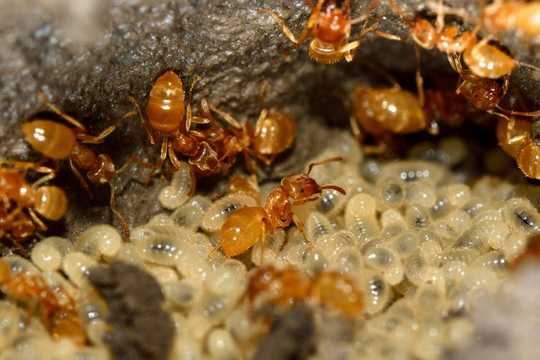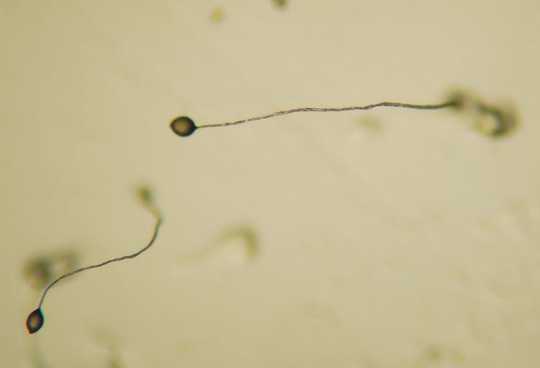
Walter Mario Stein/Shutterstock
Nature is full of animals helping each other out. A classic example is meerkat cooperation. When the group is foraging for food, one individual will head to a vantage point and keep watch for predators. This selfless individual gives up valuable feeding time for the good of others, an example of what biologists call altruism.
But why should animals be kind to each other? After all, Charles Darwin’s theory of evolution by natural selection was all about the “survival of the fittest”, with organisms that are best able to survive and reproduce leaving the most offspring in the next generation.
The last few years have seen the emergence of research into one possible explanation for altruism, a special type of gene that was originally suggested as a hypothetical thought experiment in Richard Dawkins’ 1976 book, The Selfish Gene. The discovery of real examples of these so-called “greenbeard genes” in microbes is helping change how we think about the origins of altruism.
Darwin himself saw the problem with the idea of survival of the fittest, famously highlighting the presence of worker ants and bees who don’t reproduce but instead help raise the offspring of the queen as a “special difficulty” for his theory.
The problem of explaining why animals would behave altruistically, sacrificing their own reproduction to help others, remained a prominent issue long after Darwin’s death. The solution came from the “gene’s-eye view” of evolution, epitomised in The Selfish Gene. Evolution isn’t really about the survival of the fittest organism, rather it is about survival of the fittest gene, with natural selection favouring genes that are best able to make copies of themselves in the next generation.

Cooperative ants: a special difficulty. IanRedding/Shutterstock
Altruism in ants and bees can evolve if the gene causing altruism in the worker is helping another copy of that gene in another organism, such as the queen and her offspring. By doing this, the gene is ensuring its representation in the next generation, even though the organism it is residing in fails to reproduce.
Dawkins’ selfish gene theory solved Darwin’s special difficulty, but it raised another one. How can a gene recognise if another individual also carries a copy of it? Most of the time a gene doesn’t actually need to recognise itself, it only needs to help its kin.
Brothers and sisters share roughly 50% of their genes, half from each parent. So if a gene for altruism can cause an individual to help its sibling, it “knows” there is a 50% chance it is helping a copy of itself. This is exactly how altruism has evolved in many species. But there is another way.
To highlight how a gene for altruism could evolve without directing help towards relatives, Dawkins came up with his “green beard” thought experiment. He imagined a gene with three effects. First, it needed to cause a visible signal (like a green beard). Second, it needed to give the ability to recognise the signal in others. Finally, it needed to be able to direct altruistic behaviour preferentially towards those showing the signal.
Most people, including Dawkins, viewed greenbeards as just a fantasy, rather than a description of any real genes found in nature. The main reasons for this being the unlikelihood of a single gene being able to possess all three properties.
Despite seeming fantastical, there has however been an explosion of discoveries of real greenbeards in recent years. In mammals like us, behaviour is controlled (mostly) by the brain, so it is hard to imagine a gene that makes us altruistic also controlling a perceptible signal like a green beard. But things are different in microbes.
 Dictyostelium discoideum Bruno in Colombus/Wikipedia
Dictyostelium discoideum Bruno in Colombus/Wikipedia
The past decade in particular has seen the study of social evolution take a journey down the microscope, to shed light on the fascinating social behaviour of bacteria, fungi, algae, and other single-celled organisms. One striking example is the social amoeba Dictyostelium discoideum, a single-celled organism that responds to a lack of food by forming a group with thousands of other amoeba. At this point, some of the organisms will altruistically sacrifice themselves to form a sturdy stalk, helping others to disperse and find a new food source.
Here, it is much easier for a single gene to act as a greenbeard, which is indeed just what happens. A gene that sits on the surface of cells is able to stick to copies of itself on other cells, and exclude cells that don’t match from the group.
This enables the gene to ensure that a cell’s sacrifice to form the stalk is not in vain, as the cells that it is helping will all possess copies of the gene. There are more examples too, several in marine invertebrates that encounter each other as they grow, and fuse if they detect a match at a greenbeard gene.
A dark side
Another intriguing finding from recent studies is that greenbeards have a dark side and don’t have to involve altruism. If a gene is able to recognise whether it is present in another organism, it makes sense that it would gain an advantage by harming an organism that doesn’t possess the gene. This is exactly what happens in the soil bacterium Myxococcus xanthus, where a mismatch at the greenbeard gene causes individuals to inject a lethal toxin.
The study of greenbeard genes is still very much in its infancy, and we don’t truly know how widespread and important they are in nature. In general, kinship has a special place at the heart of the evolution of altruism, because it is through helping relatives that a gene can ensure it is helping copies of itself. Perhaps our focus on the enigmatic social lives of birds and mammals has driven this view, as the social lives of these groups tend to revolve around families. But the story could be very different for microbes and marine invertebrates.![]()
About the Author
Laurence Belcher, PhD Candidate in Evolutionary Biology, University of Bath and Philip Madgwick, PhD Candidate, University of Bath
This article is republished from The Conversation under a Creative Commons license. Read the original article.
books_awareness
























